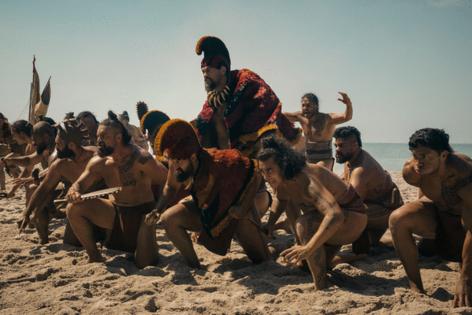'Chief of War' review: Hawaiian history comes to life courtesy of Jason Momoa
Published in Entertainment News
Starting in the late 1700s, a bloody series of conflicts between competing kingdoms jostling for power ultimately resulted in the unification of the Hawaiian islands in 1810. That drawn-out process is brought to life in the Apple TV+ historical epic “Chief of War,” starring Jason Momoa as a high-status war general who is also a man of few words. Because much of the series is in Hawaiian, the subtitles register all the sounds he employs instead: “growls,” “sighs,” “grunting” and, of course, “groaning, breathing heavily.” It’s thrilling how much he’s able to convey with just a look — Momoa gives a good glare — and a guttural sound.
It’s Momoa’s strongest performance to date, and he is also one of the show’s creators with Thomas Pa’a Sibbett. Much of the cast and crew are Hawaiian as well, and though the series was largely filmed in New Zealand, there’s an appealing sincerity to the project. The story and history of Indigenous Hawaiians haven’t shown up on screen with quite this kind of large-scale budget and ambition. Even so, it will be up to Hawaiian audiences to determine how successful the show is in capturing this history.
Momoa plays Kaʻiana, a real person who is living quietly in self-exile in Kaua’i with his wife, her sister and his two brothers. They are tolerated, but outcasts. It’s preferable to living under the manipulations of Kahekili, Maui’s megalomaniac king (played by a formidable Temuera Morrison) because all things being equal, Kaʻiana isn’t a man who wants to fight. He will if he has to, but he wants no part of the pointless violence Kahekili demands to advance his power-hungry agenda.
Kaʻiana is content to focus on more prosaic concerns. Early on, we see him diving off a catamaran into the water, where he lassos a shark. As they tow it back to shore, he places his hand on the creature and says of the sustenance it will provide the village, “In your death, may life be preserved.”
Momoa’s massive physique is always an element of his screen presence, but with no bench press or barbells around, would swimming and rowing and hunting make for a man this swole? Apparently, yes! An English trader once described Kaʻiana as a man of “Herculean appearance” who carried himself with considerable dignity. “Having lived in the habit of receiving the respect due to a superior rank of his own country, he possessed an air of distinction.” Momoa captures all of this.
Kaʻiana’s placid existence comes to an end when Kahekili commands his return. The king tells him that Maui is vulnerable to an invasion from the kingdom of Oahu. Kahekili is untrustworthy, but also knows what buttons to push and convinces Kaʻiana to lead a preemptive attack. An atrocity ensues, Kaʻiana’s family flees, but he isn’t so lucky, and somehow finds himself on a ship of “pale skins” — as they refer to the British traders who periodically appear — headed to Zamboanga in the Philippines.
It’s unclear how long Kaʻiana is on the ship, but in that time he is befriended by another outcast, a runaway slave named Tony (James Udom) who teaches him English, and Kaʻiana uses this newfound knowledge to pursue a specific goal once they reach the port: He’s seen the power of muskets and intends to bring a cache of them back to arm his people against the despot Kahekili, as well as any other threats. Turns out the king of Hawai’i (Cliff Curtis) is nursing plans of a takeover himself.
When Kaʻiana finally returns to the islands, he’s no longer wearing a loincloth, but the britches of Western men. “Why do you cover your legs like the pale skins?” his brother asks. Because foreign men are “obsessed with hiding their genitals,” Kaʻiana replies sardonically. “They cover both legs to ensure it.” I wish the show allowed for more moments like this, with humor peeking through, and also more time spent on the rhythms of daily domestic life.
With a score by Hans Zimmer, “Chief of War” has big aspirations to entertain, similar in scope — and brutality — to a fantasy like “Game of Thrones” or a historical fiction like “Shōgun.”
In fact, its similarities to “Shōgun” are uncanny. That’s not necessarily a critique — of warring regional factions; of a watchful, high-ranking young woman who is subtly trying to exert her influence on matters ultimately decided by men; of a white sailor stranded in an unfamiliar place (a minor character here, but between he and Kaʻiana, it’s as if there’s an unofficial exchange program going on); of sexual tension between a man and a woman that cannot be acted on; of the introduction of gunpowder and European tools of warfare; of large-scale battles and their graphic results. You don’t call a show “Chief of War” without delivering on that promise.
That’s not what kept me watching, though. None of it would work without Momoa’s considerable screen presence. Kaʻiana is a complicated figure. He’s a strategic thinker with a profound loyal streak, but he is not invincible or without fear, and we know this because Momoa lets these moments wash over his face. When he’s challenged to ride a slide-like device down a cliff, he girds himself for what’s coming, but his angst and quiet terror are there as well, and it feels so human. There’s a lot of subtlety to his performance.
That’s also true of Luciane Buchanan as Kaʻahumanu, the aforementioned woman trying to manage all these male compulsions, and the actors who play Kaʻiana’s family (Siua Ikale’o and Te Kohe Tuhaka as his brothers, and Te Ao o Hinepehinga and Mainei Kinimaka as his wife and sister-in-law). The show is asking a lot of its cast, and newcomer Kaina Makua, as Kamehameha (who would ultimately rule over a unified Haiwai’i), struggles to convey what the man is thinking each time he refuses Kaʻiana’s pleas that they take a proactive approach to the threats bearing down on them. Momoa has a decades-long career in front of the camera to draw on when it comes to emoting without accompanying words; asking the same of someone without previous acting experience often proves too much.
The season ends on a weird note, with a tense conversation amid a group sex scene. It’s an exchange of dialogue that more or less says “To be continued,” and there’s always a more narratively satisfying way to close out an arc while still allowing for more storytelling if the show is renewed.
Even so, “Chief of War” is visually distinct and gorgeous, from the landscape to the regalia worn by Kaʻiana and other nobility, of cloaks and elaborately shaped helmets, both covered in feathers of a rich golden yellow and a deep red. The show can be exceedingly gory — there’s a scene of exacting, exhausted revenge that comes at the hands of a rare woman warrior — but I was taken with some of the more theatrical details around these moments of violence, including the exchange of insults that precede the final battle.
———
'CHIEF OF WAR'
3 stars (out of 4)
Rating: TV-MA
How to watch: Apple TV+
———
©2025 Chicago Tribune. Visit chicagotribune.com. Distributed by Tribune Content Agency, LLC.













Comments